SUMMARY
This is AI generated summarization, which may have errors. For context, always refer to the full article.
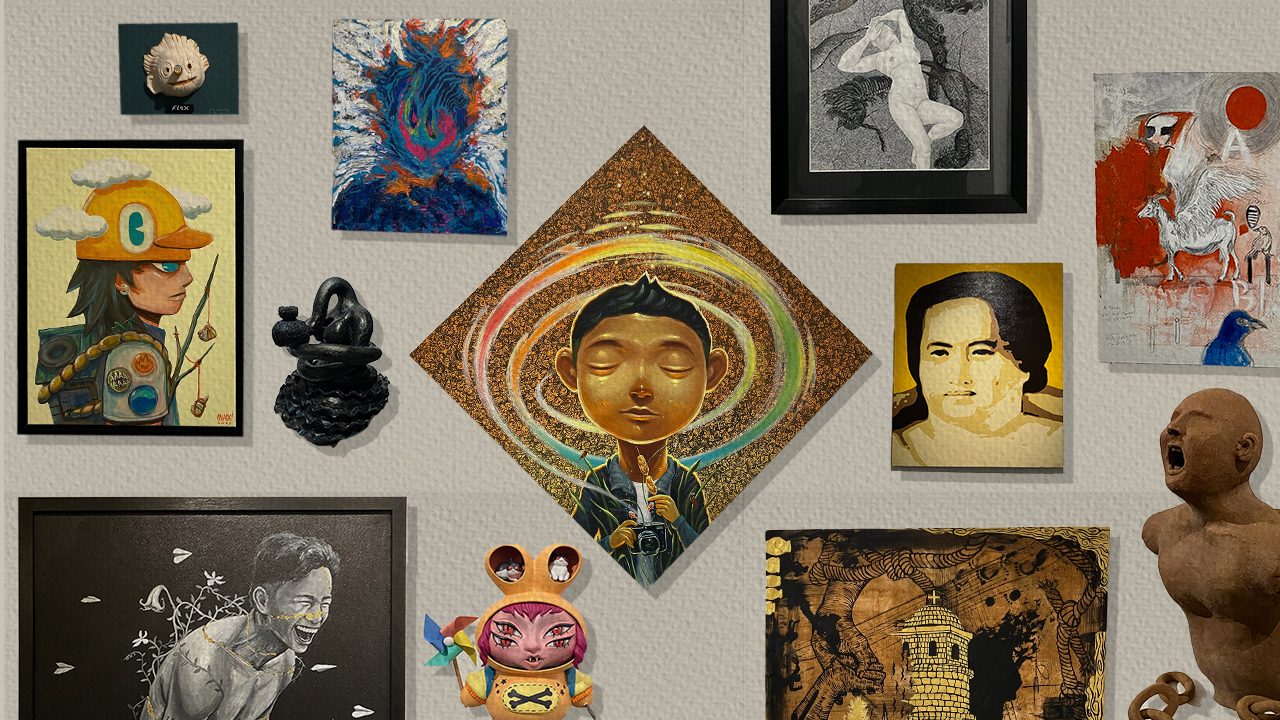
For the love of all that’s good and beautiful, if you’re in Dumaguete City, Negros Oriental before the 26th of November, you must find the time to visit MUGNA Gallery over in Valencia town. Displayed on its walls right now is an extraordinarily curated group exhibition, executed by Ixx as part of the festivities around the recently concluded Buglasan Festival — which gives a precise overview of the state of Dumaguete fine arts at the moment, in the immediate aftermath of the pandemic, and on the cusp of a future that’s filled with promise.
There is an uncommon sense of culmination to be felt in the whole of KaMugnaAn, which groups together 38 visual artists who call Negros Oriental their home. What I mean by this is that this show feels very much like a continuation — and also a grand elevation — of that pandemic project titled Atoa. If you remember, that was a group exhibit that opened early in 2021 at Dakong Balay Gallery, and provided the artists of Dumaguete an inciting trigger which made possible the great flowering of visual arts in the city in the midst of the pandemic. Atoa initiated a continuous flow of exhibitions throughout the rest of the pandemic years, and in the various galleries that popped up during that strange and confounding time — including a sequel, Atoa 2, which bowed in 2022. For that initial show, I wrote for the Philippine Daily Inquirer: “[The exhibit shows] a collective ‘atoa,’ and with that, a sense of community pride. They herald an excitement for what’s brewing in the local art world. They signify cultural light in our current darkness — Dumaguete still at it for…its local celebration of [the arts]. They defy hoary, outside formulations — showing us that Dumaguete artists are at once gloriously local but also very much at home in the world.”
If Atoa staked a claim, KaMugnaAn is the final flag that marks distinct territory.
A crash course on 38 artists
Because what is gathered here are works that represent most of its artists with the distinct styles they’ve found for themselves since 2021. And because the show also introduces us to new Dumaguete artists coming into the fold, as well as older artists now finding their way back home. And finally because, despite the disparity of subjects and styles, Ixx found an uncanny way to connect them all — with the show itself becoming a narrative of the Negros Oriental experience, a necessary prescription for the provincial festival it was meant to showcase.
Step into MUGNA’s space, and you will find a virtual yearbook of the exhibits that have come to being in the past three years. Babbu Wenceslao’s “Anino ang Anino sa Adlaw” is a reflection of his Republic and Asanamo exhibits, with its attendant attention to acrylic, LED lights, and fiberglass mixed media, and his unvarying focus on social issues, like the environment; Amelia Duwenhoeger’s “Rabbits” is taken from Dual/Ities, where she showed a penchant for mice and rabbits frolicking about in familiar human shenanigans; Daniel Vincent’s “Wars and Missiles” is a continuation of a translucent project in abstraction he first showcased in Diverse/Reverse; Faye Manalo’s “Lost and Found” is a darker take on her ripple-and-line art that glowed with brighter sheen in Ripples and Introspection; Hemrod Duran’s “King” continues his feel for representational clay art from New Works, this time with an eye on chess pieces (you can see a fuller display of this current tendency in a limited exhibition at the National Museum of the Philippines in Dumaguete); Iris Tirambulo’s “Halaran” continues her textile/insect explorations about domesticity and motherhood from Halad; Jana Jumalon’s “Passage” finds her making new terracotta shapes straight from Tierra Quemada; Jomir Tabudlong’s “1450-2023” defines more spectral colors interlaced with found images from Pieces Align; Juan Macias’s “Determinism” continues his somber collage works from Sonder.
Jude Millares’ “Hand-Over” goes for even starker pagan shapes and motifs he first plumbed in Journals; Moshi Dokyo’s “Sag Asa” mercifully pushes his comic depressed art persona from ProQuackStinate into a more hopeful composition; Mikoo Cataylo’s “Dire Ta,” with its painful rendition of a limbless man in chains, continues the provocative assault on social issues we first glimpsed from Pakigbisog sa Kailaloman; Alta Jia’s “The Future is Not Ours to See” is another of the artist’s exquisitely rendered pen-and-ink probing into psychological vistas we have seen from all the group shows she appeared in, most especially Manifest; Kitty Taniguchi’s “Untitled (A Study for the Series, The Vicinity)” continues her endless fascination for mythic winged horses and black crows, this one stained by a red sun; Dolly Sordilla’s “Playdate with Poppy” gives us more whimsical polymer figures in shiny acrylic colors straight out from Ambot Gubot; Rey Labarento’s “Owhi Really?!” pursues the same thread-outlined social scenes he pioneered in At the Moment; Trina Montenegro’s “Mystery Plant” takes off from the aboriginal-tinged botanical macroviews of Windows of Perception; Viviana Riccelli’s “The Angel of Mount Talinis” plumbs deeper into transcendental abstraction we first caught in States of Mind: A Dialogue Between the Inner Self and Multiple Realities, and Jutsze Pamate’s “Flex” continues his sculptural work commenting on modern realities, using a Pinocchio head, from KomBaTe.
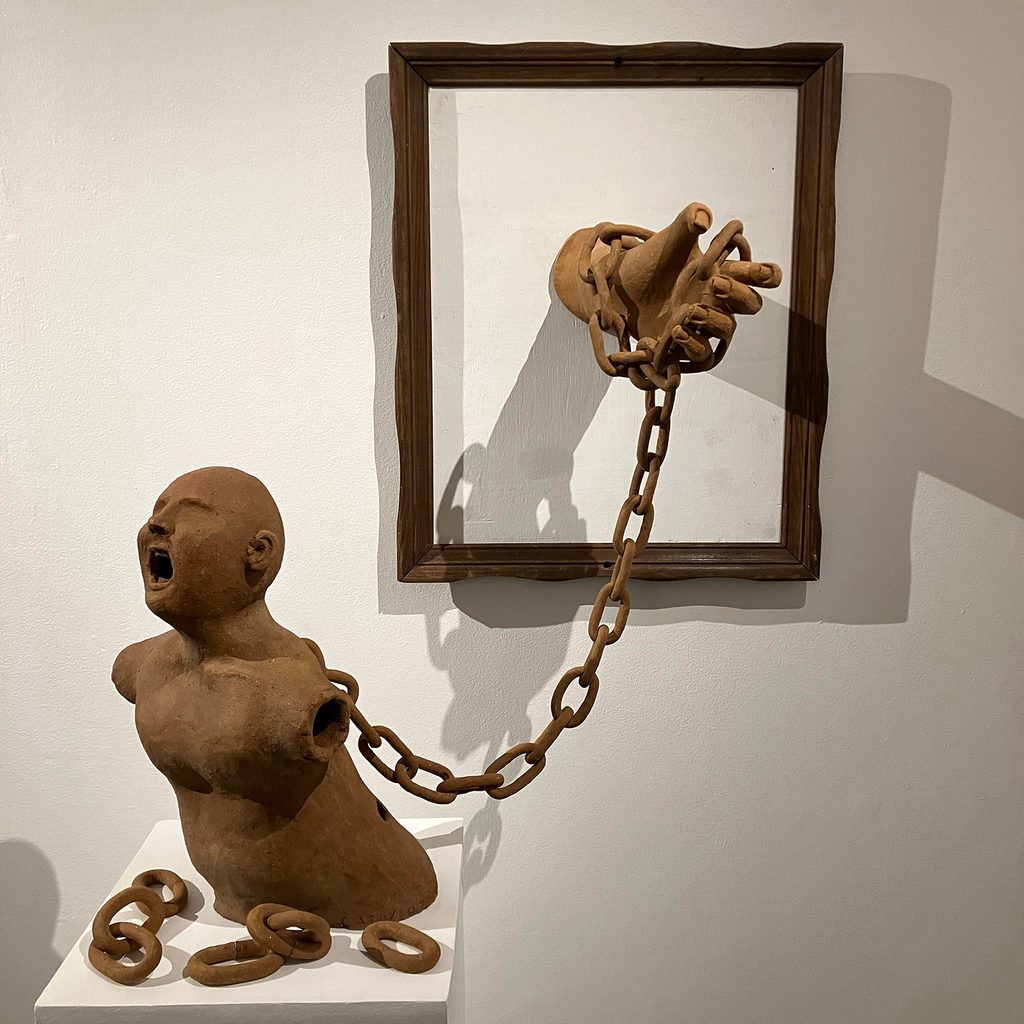
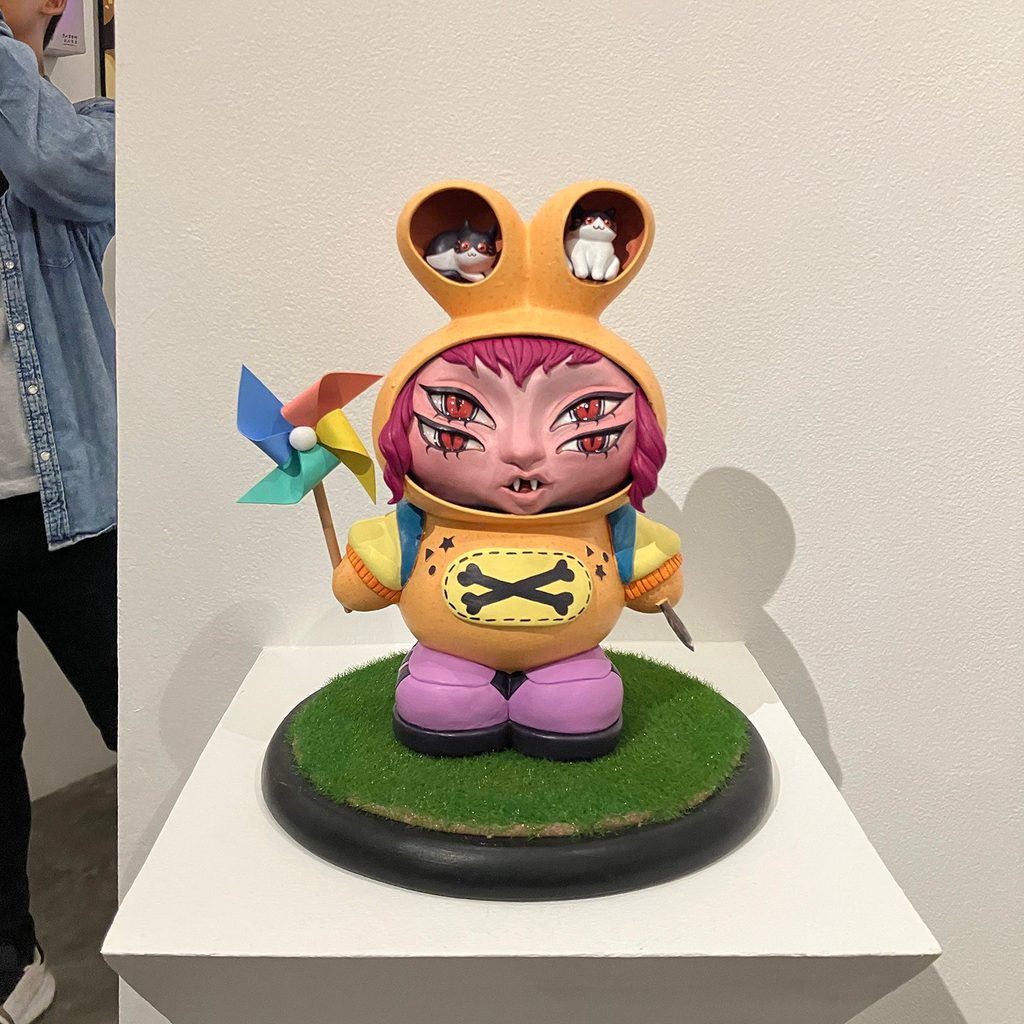

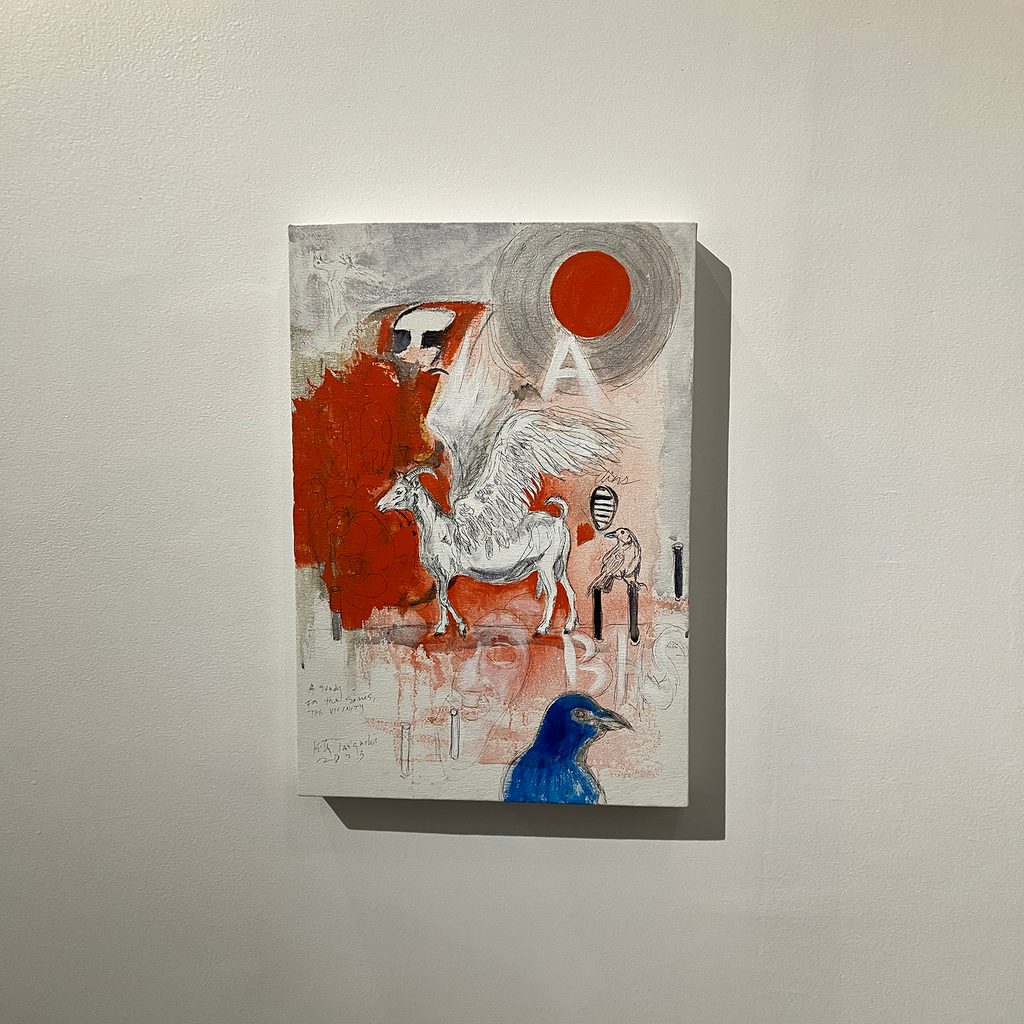
All of these are exhibits from the last three years or so. But Hersley-Ven Casero extends it even further: in “ginhawa (breathe),” he takes an illustration he made for a children’s story from my 2012 short story collection, Heartbreak & Magic, which we exhibited in his first solo show, Uncommon Magic, and updates that image of a boy with magical things swirling around him into this self-portrait — a photographer with a camera in tow, eating bananacue while inspiration swirls around him in rainbow colors, which is the closest Mr. Casero has ever confessed, on canvas, on how the magical has truly informed his art-making.
This is all to say that if you missed following the sheer development of Dumaguete art in recent years, KaMugnaAn is your most welcome crash course.
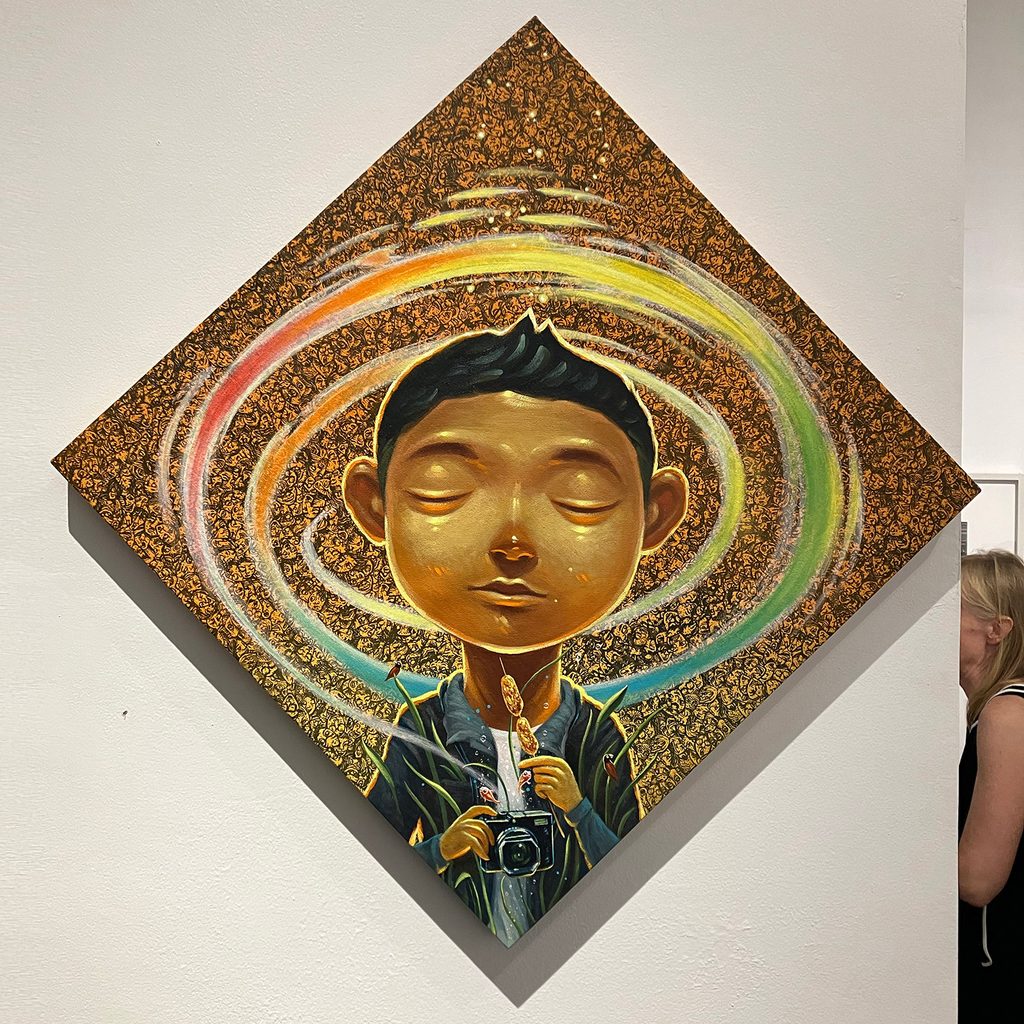
New faces, returning faces
The show also showcases the art of familiar artists who really need their own solo shows soon — Mariana Varela, for example, whose “Sigbin” exhibits teeth that sink deeper into her mythology of being she has explored before; or Kevin Cornelia, whose “Padayon” is perhaps my favorite in this crop of works — a black and white portrait of a laughing young man paradoxically intertwined by flying paper planes and gumamela blooms whose leaves encasing the body are not distinguishable from thorns; or Portia Nemeño, whose “Sugilanon” borrows the style of art nouveau in this painterly rendering of local mythology; or Gerabelle Rae, whose “The Dreaming of Escape” is a surreal wish fulfillment of childlike wonder; or Dyn Quilnet, whose “Embrace II” is a mixed media evocation of misshapen maternal nightmares. There’s also Rovan Caballes, who takes off from Warholian prints to present an acrylic portrait of his grandmother Ines Serion, the first female mayor elected in the Philippines.
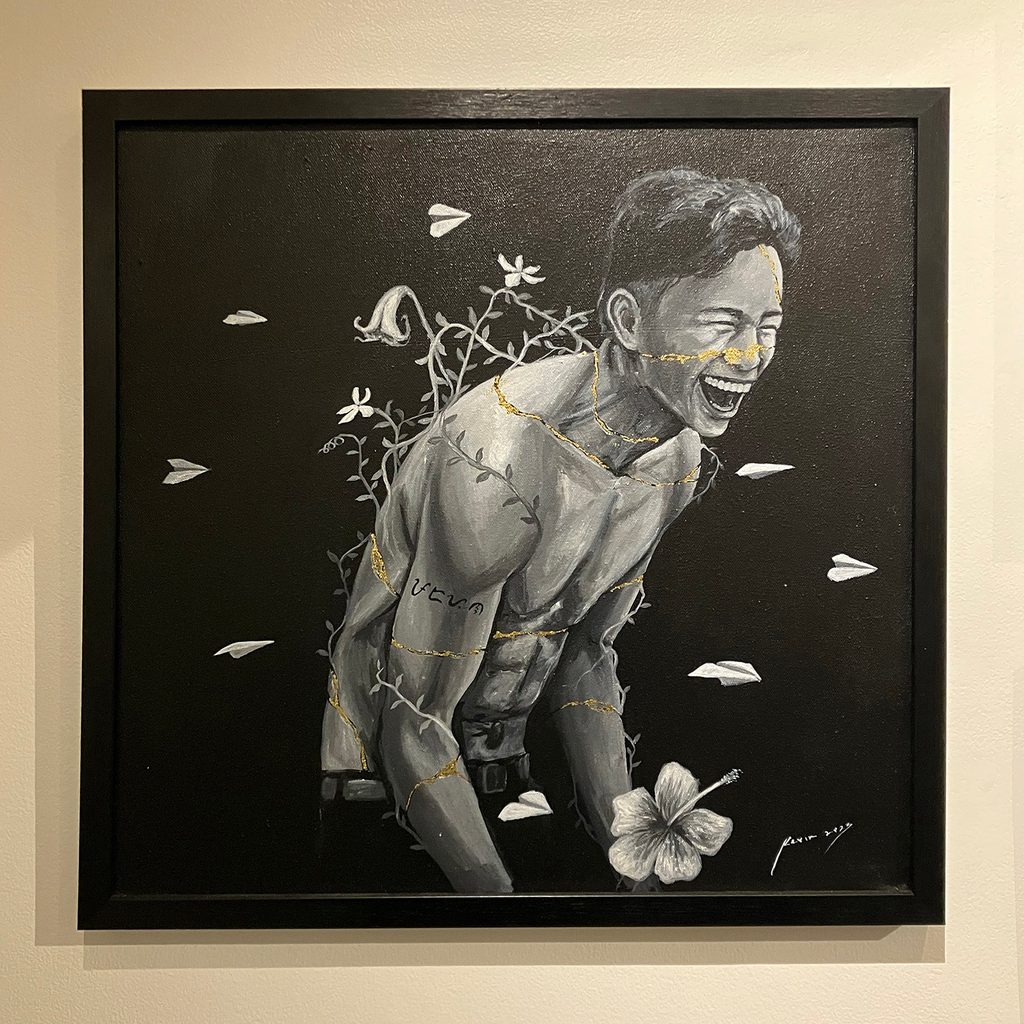
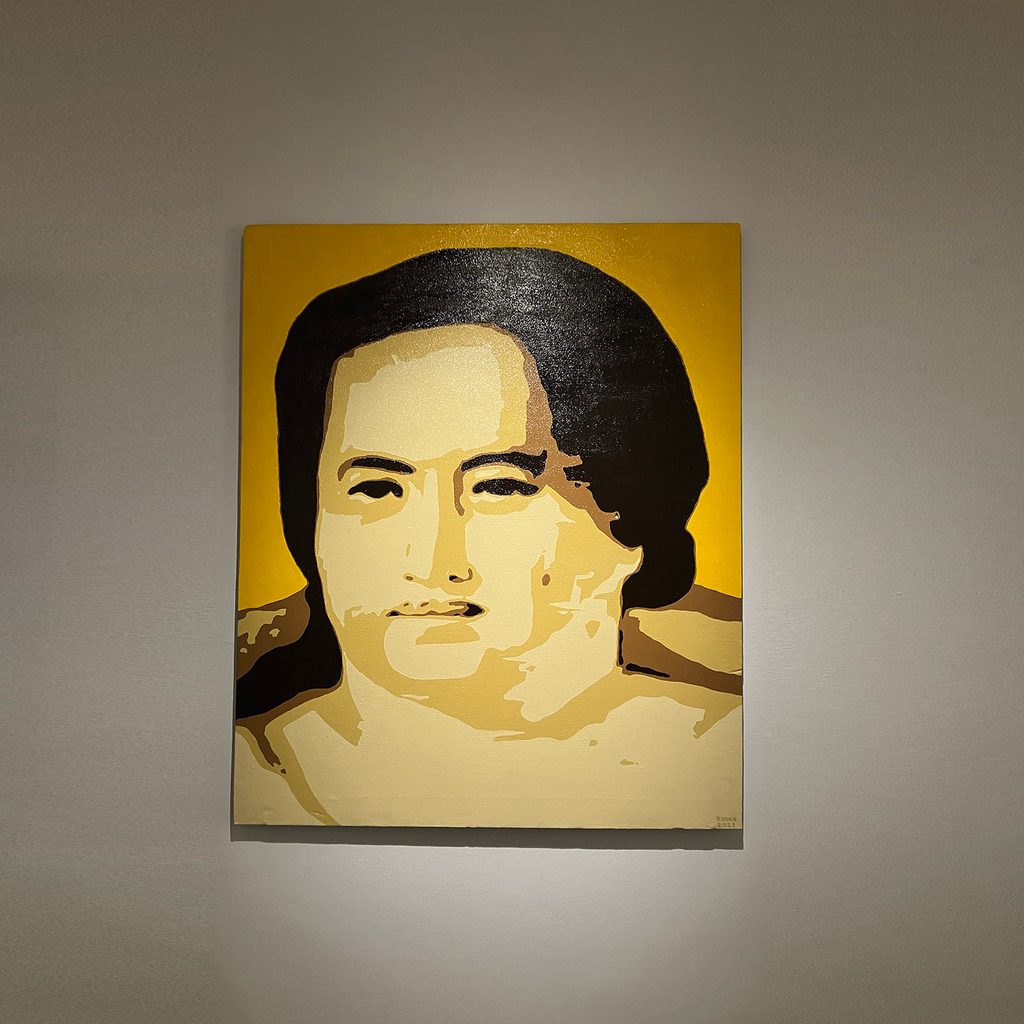
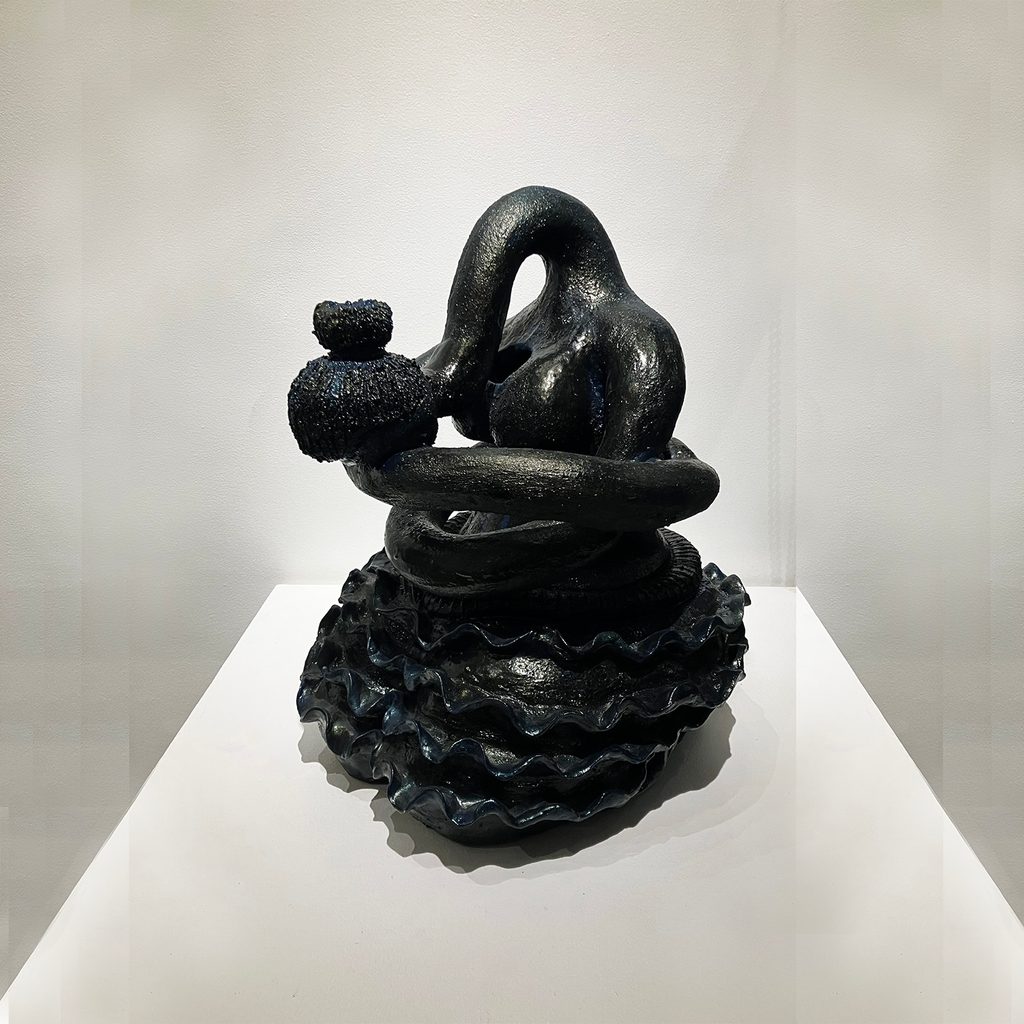
All told, I am happiest for Jutsze Pamate, who was the face of Dumaguete visual arts in the 1990s and 2000s, and who has come back to the scene quite unexpectedly, first with a pop-up at the El Amigo Art Space a few months ago, and now with this inclusion in KaMugnaAn. This for me is part of the appeal of the exhibition — that while it celebrates the vibrant art of the current crop of young artists in Dumaguete and Negros Oriental, it also makes accommodation for those who have come before. I can hope for the inclusion of other artists like Maria Taniguchi or Paul Pfeiffer or Kristoffer Ardena or Susan Canoy or Cornelio Aro (the last two would be a great addition to the show with the theme of “Negros Oriental”), or even Karl Aguila and Bong Callao — but 38 artists are already quite a handful.
The show also introduces us to the works of a handful of artists whose works I want to see more of. This includes Budoy Marabiles, whom we all know as an EDM master and frontman for Original Sigbin, whose “Santelmo” is a Rorschach ink blot test of what could be monstrous; photographer Carmen del Prado, whose “Piggy Bank” is a veritable diptych of a beach scene from the same day but at different times and moods — demonstrating the fleeting quality of the world we inhabit; Jenny Alvarez, whose “Metanoia,” awash in pink hues, playfully divert us from the subtle threat of her main image — a pair of hands in the process of scissoring a flimsy pink thread; Koki, whose “Ghosting (Talinis)” is a work of unglazed porcelain that mimics the unfurling of a white and ghostly sheet, but presents itself as a metaphor for Dumaguete’s nearby mountain; Marjo Banagua, whose “Dumagit (Captivate)” captures in sepia tones in acrylic and line art the basic allure of Dumaguete, with the campanario as its focal point. (Other artists featured in the exhibition include Samnathis, Sandy Dupio, Ma. Isabel Gutang, JO Camille, Florenz Dionisio, Dani Sollesta, and Dan Dvran.)
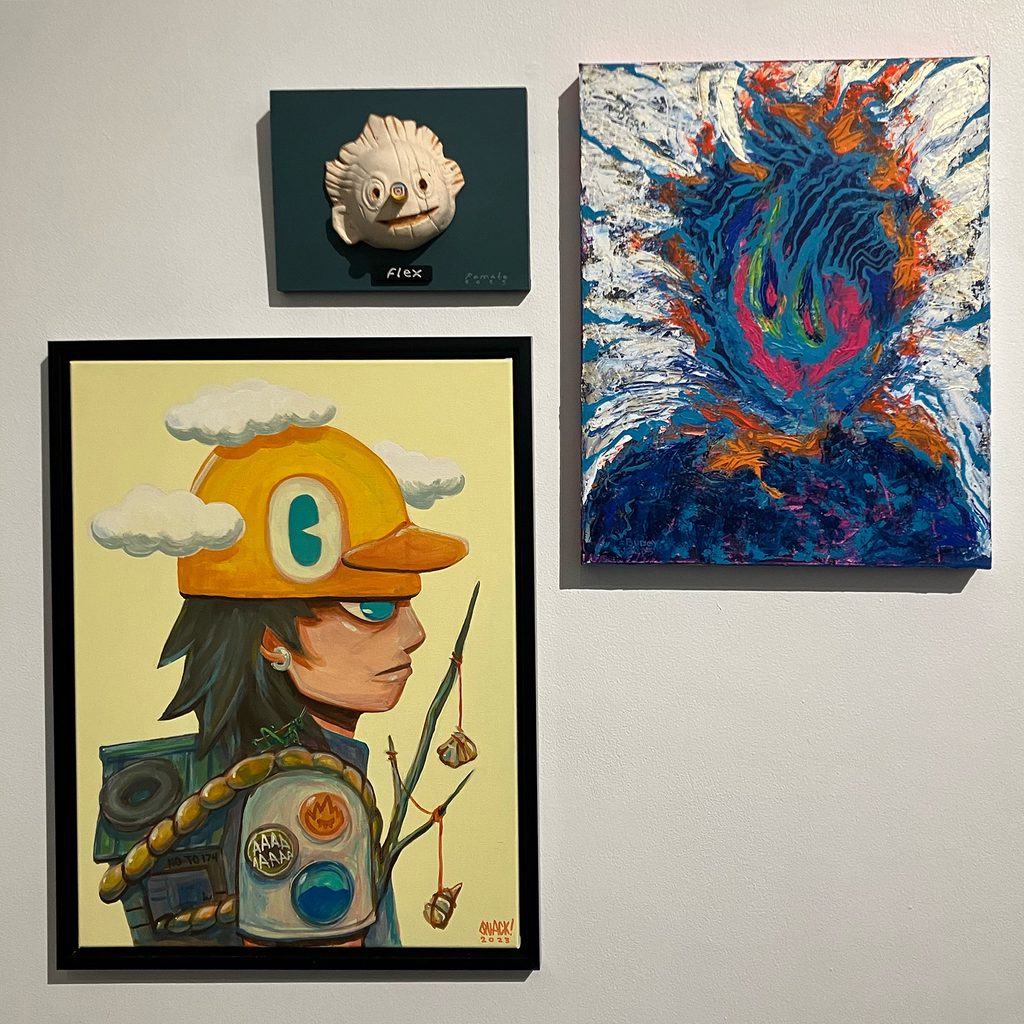
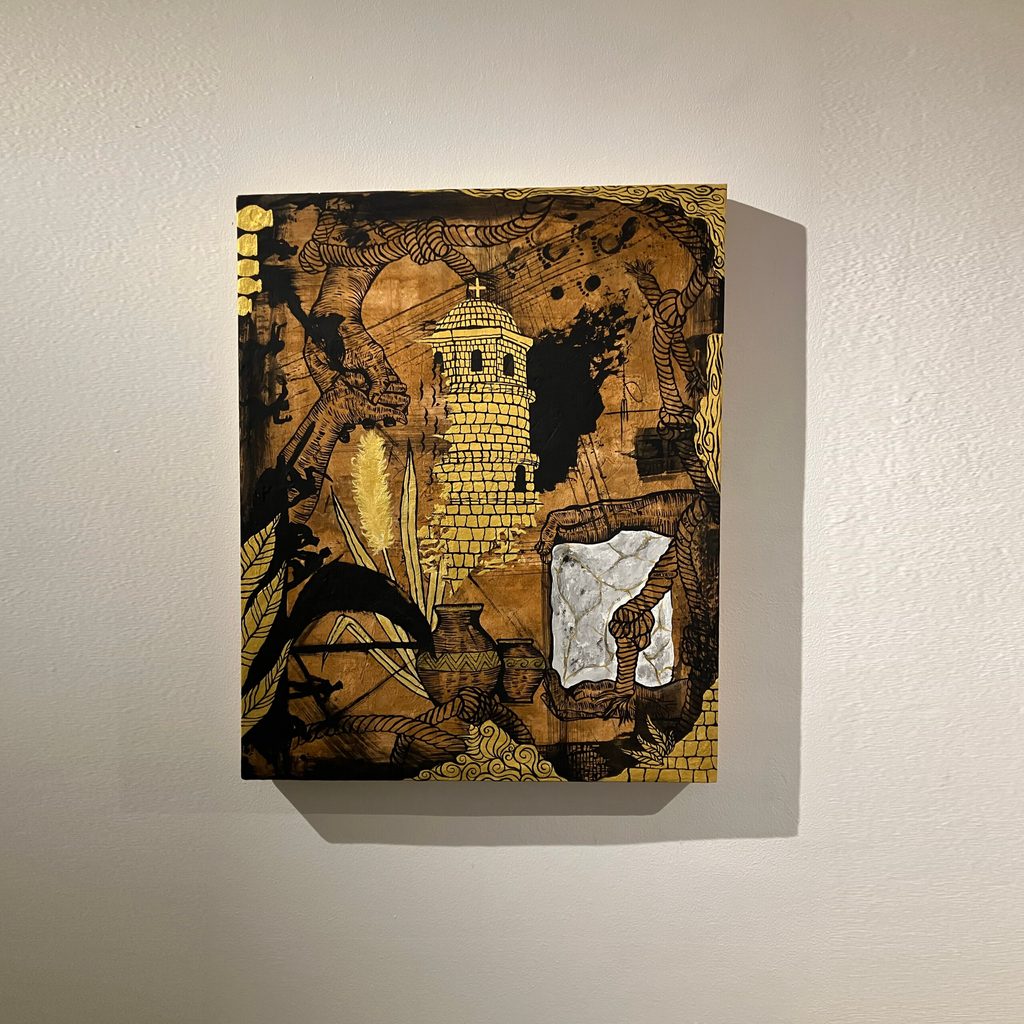
In the name of ‘garbo’
As far as I know, these works were prompted by the Buglasan Festival’s theme of “Garbo sa Kabisay-an,” in essence a celebration of Oriental Negrense scenes — and perhaps cares. You could see efforts in that respect, in particular the works of Sandy Dupio, Carmen del Prado, Viviana Riccelli, and Gerabelle Rae (portraying natural landscape), Portia Nemeño (portraying literature), Marjo Banagua (portraying iconic spots), Mariana Varela and Budoy Marabiles (portraying lower mythology), and Rovan Caballes (portraying history) — but the theme has been thoroughly processed by each of their artistic sensibilities, while the rest of the works in the exhibition, I believe, present to us the Negros Oriental of their imagination, both in delight and deprecation, in pleasure and in pain. That duality is important, and the fact that this exhibit acknowledges that is to its credit.
Curator Ixx does recognize the disparity in styles — but sees common ground in terms of depictions of places and people, finding in each one a unique element of the Negrense. He notes in his program for the show: “Putting together an exhibition to highlight the wealth and number of different styles, techniques, and personalities of a locale is always a herculean task, as the push and pull, the width and breadth of experience and paradigm manifest in countless ways. Overcoming this, Mugna Gallery, in celebration of the Province of Negros Oriental’s Buglasan Festival [in] 2023, presents an exhibition that gathers local artists and ties them along the string that is the Dumaguete creative spirit — a KAMUGNAAN like nothing else.”
We will take him at his word: this is a celebration of a communal creative spirit. – Rappler.com
KaMugnaAn runs until November 26 at MUGNA Gallery, Unit 1 Uypitcing Building, Jose V. Romero Road, Bong-ao, Valencia.
Add a comment
How does this make you feel?



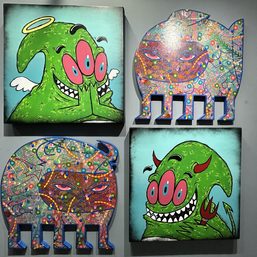
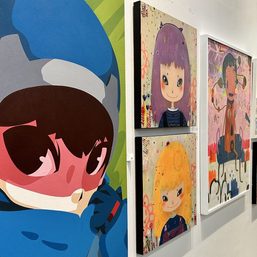
There are no comments yet. Add your comment to start the conversation.